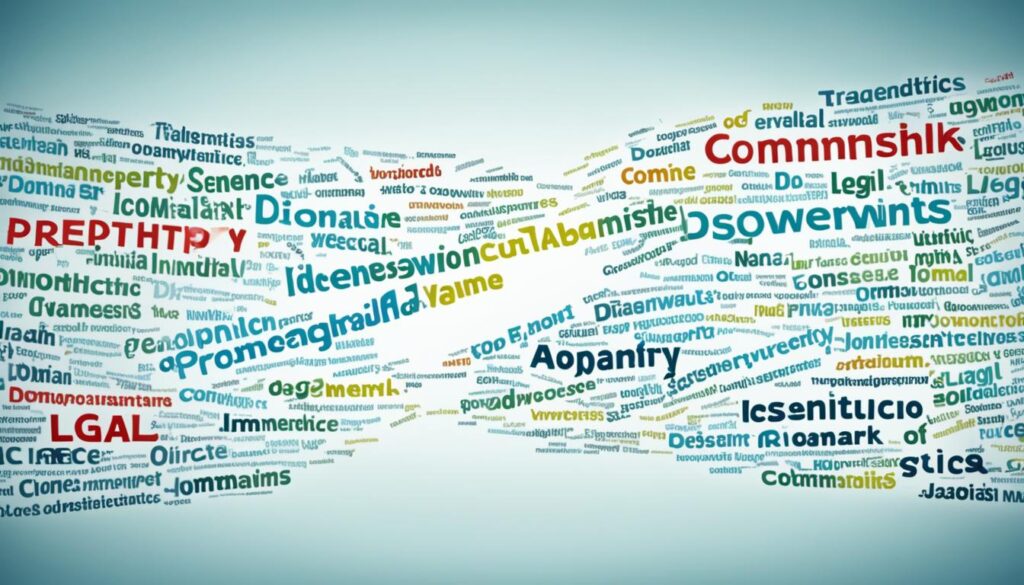Registering a domain name is not just about finding a cool web address. It includes legal duties that are very important. Knowing all about owning a domain, trademarks, and possible legal issues is key. This knowledge is essential for businesses or individuals starting with domains.

ICANN’s Uniform Domain-Name Dispute-Resolution Policy (UDRP) is crucial for managing domain disputes. This policy helps solve issues like trademark infringement or cybersquatting. If someone breaks the rules, they can face legal action. So, it’s important to understand trademark laws and how to handle disputes.
Key Takeaways:
- Registering a domain name comes with legal obligations and considerations.
- The ICANN UDRP governs domain name disputes related to ownership, trademarks, and cybersquatting.
- Trademark laws apply to domain names, and infringing on a trademark can lead to legal action.
- Choosing a reputable domain name registrar and conducting due diligence is crucial in avoiding legal issues.
- Understanding the UDRP proceedings and taking a proactive approach to domain name legal considerations is key.
Understanding Domain Names and the Law
When you register a domain name, you’re making a legal agreement. You must follow the rules set by ICANN’s UDRP. This helps solve any disputes about domain names fairly. If someone challenges your domain name, they can complain. This could lead to you losing your domain.
It’s against the law to pretend to be another business, use their trademarks, speak badly about them, or grab domain names unfairly. If you own a domain name, it’s your job to know the law and follow it.
Let’s examine the major legal details around domain names:
Legal Contract with ICANN
Registering a domain name means you agree to certain rules with ICANN. This contract explains what you can and cannot do with your domain. It protects you and others involved.
Domain Name Disputes
Disagreements about domain names happen when someone thinks you’re using their name unfairly. They can file a complaint with ICANN’s UDRP. If they’re right, you might have to give up your domain name.
To stay out of trouble, don’t do things that could cause a dispute. This includes taking trademarks, misleading people, or hoarding domain names. Knowing and following the laws will keep your domain safe.
The Role of Trademarks
Trademarks are very important to domain names. If your domain name uses someone else’s trademark, you could face legal issues. Just picking another ending for your website name doesn’t make it okay.
Before you pick a domain name, search for trademarks carefully. This ensures your name doesn’t step on someone else’s rights. Being careful from the start can stop legal problems later on.
“Compliance with trademark laws is crucial when choosing and protecting a domain name. Conducting a comprehensive trademark search prior to registration can save you from costly legal battles.”
Knowing the law about domain names helps you keep a strong and lawful online presence. Next, we’ll dive into trademark laws and how they affect domain names.
Trademark Law and Domain Names
Trademark law is very important for domain names. If you register a name too close to a known trademark, you could face legal issues. This is true even if you use a different top-level domain.
To avoid legal problems, always search for trademarks before picking your domain name. Do this search at the relevant trademark office. This way, you’ll make sure your domain name doesn’t step on any trademark toes.
A good trademark search can help you choose wisely and stay out of trouble. It’s a critical step for keeping your business reputation safe and avoiding costly disputes. Trademark law is powerful, especially in the world of domains.
The Importance of Trademark Searches
Before you pick a domain name, do a thorough trademark search. This can reveal if there are similar names or categories already trademarked. With this search, you minimize the risks of infringing on someone else’s trademark.
“Registering a domain name without a trademark search is risky. It’s vital to check your domain name against existing trademarks to avoid legal issues.”
Trademark laws help protect businesses and their creative rights. By searching for trademarks first, you’re making sure your domain doesn’t cross legal lines. Doing this keeps you in compliance and out of trouble.
Choosing the Right Domain Name
It’s crucial to pick a unique domain name that doesn’t encroach on trademarks. Think about using words or phrases that aren’t generally linked to other brands.
Follow trademark laws closely and research thoroughly. This will help you select a domain that represents your brand without legal headaches. Being cautious and legally aware is key.

Protecting Your Business with Trademark Law
Trademark law lets you protect your brand’s identity. Register your trademarks and defend your rights to keep your brand safe from infringement.
Keep an eye on your domain name for any misuse. Check regularly for cybersquatting or trademark issues, and act quickly if you find problems.
Knowing about trademark laws and how they affect domain names is vital for a strong web presence. Respect trademark rights and protect your business by being proactive. This is how you manage the tricky relationship between trademarks and domains.
Navigating Domain Name Disputes
Organizations like the World Intellectual Property Organization (WIPO) are essential in domain name disputes. They include issues like trademark infringement and cybersquatting. WIPO helps solve these disputes while following worldwide laws.
Cybersquatting means someone wrongly registers a domain name, affecting a trademark. It causes confusion, harms reputations, and leads to financial losses.
To avoid these issues, many companies register various domain names similar to their trademarks. This action helps them protect their rights and control their online image.
| Key Points | Benefits |
|---|---|
| 1. WIPO Resolution: | WIPO offers a recognized and effective platform for resolving domain name disputes, ensuring fair and impartial resolutions. |
| 2. Compliance with Laws: | By resolving domain name disputes, WIPO helps maintain compliance with intellectual property laws globally. |
| 3. Mitigating Cybersquatting Risks: | Proactively registering multiple versions and TLDs of trademarked names can reduce the likelihood of falling victim to cybersquatters. |
It’s essential for businesses to keep an eye on their domain names to prevent misuse. If they find any unauthorized use, taking quick legal steps is crucial. This helps protect their brand and reputation.

The Perils of Cybersquatting
Cybersquatting is a big risk for businesses. It means registering a domain name that belongs to someone else. This could be through trademark infringement or getting a similar version of the name. It can hurt or misrepresent a business’s reputation.
Businesses fight cybersquatting by registering related versions of their name. They also get country-code top-level domains of their trademarked name.
Cybersquatting is a major issue. It breaks intellectual property rights and fools internet users. It makes people think they are dealing with the real trademark owner.
Cybersquatters register domain names similar to well-known trademarks. They misuse the brand’s good name. This can cause financial loss, damage to reputation, and legal trouble.
Trademark Infringement and Domain Name Infringement
Cybersquatting is both trademark and domain name infringement. Cybersquatters use a name very close to a registered trademark. This misuses the brand’s reputation. It breaks the exclusive rights of the trademark owner. It harms their business.
Domain name infringement also happens without directly breaking a trademark. It confuses internet users. This confusion can make the real trademark owner lose customers and miss business chances.
The Consequences of Cybersquatting
Cybersquatting has wide effects. It impacts both businesses and consumers:
- **Trademark Infringement Lawsuits**: Trademark owners can sue cybersquatters. They can ask for damages for trademark infringement.
- **Reputational Damage**: Cybersquatting can damage a brand’s reputation. It makes consumers distrustful and hurts brand value.
- **Loss of Customers and Revenue**: It can make potential customers go to the wrong website. This leads to financial losses.
- **Compromised Online Presence**: Cybersquatters might make fake websites using the infringing domain. This risks visitor security and spoils the real brand’s online image.
Businesses need to keep an eye on their trademarks. They should act fast against cybersquatting. Doing this can prevent risks, protect the brand, and save its integrity.

Being quick to react to cybersquatting helps save intellectual property rights. It keeps the online image clean and protects the brand reputation.
Understanding UDRP Proceedings
The Uniform Domain-Name Dispute-Resolution Policy (UDRP) is a way to resolve domain name disputes. This is through arbitration. If you’re a trademark holder, you can complain against someone you think is using your mark wrongly.
An independent panel reviews everything during UDRP proceedings. They look at how close the domain name is to the trademark. They also consider if the registrant has a real interest in the name. And if the name was registered in bad faith. Then, the panel decides.
If the panel agrees with the complaint, they can either cancel or transfer the domain name. This way, the trademark owner gets control back. But remember, UDRP rulings can be challenged in court. Both sides have this option.
Advantages of UDRP Arbitration
UDRP arbitration is fast. Cases often conclude within two months. This helps trademark holders get their property back quickly.
Also, UDRP is less expensive than court battles. The process is simpler and costs less. This makes it easier for trademark owners to defend their rights without spending a lot.
The UDRP process offers a balanced and impartial approach to domain name disputes, allowing trademark holders to assert their rights and remedy infringement efficiently.
Working with UDRP Experts
Although not required, having legal help with UDRP can improve your odds. UDRP experts know a lot about trademark disputes. They’re also skilled in arguing your case using UDRP rules.
Professionals make sure your complaint is strong and well-presented. They help you prepare and show strong evidence. They also help spot weaknesses in the other side’s argument. This strengthens your case.
| Key Points | Benefits |
|---|---|
| UDRP provides a structured process for resolving domain name disputes through arbitration. | Speedy resolution allows trademark holders to regain control of their intellectual property promptly. |
| An independent panel reviews evidence presented by both parties and issues a ruling. | Cost-effective alternative to traditional litigation with lower legal fees involved. |
| UDRP rulings are not binding in a court of law, and both parties can challenge the decision if desired. | Engaging UDRP experts maximizes chances of success and strengthens your case. |
Understanding UDRP proceedings helps trademark holders protect their rights. With the help of UDRP experts, they can defend against misuse of their domain names. Protecting your intellectual property in the digital age is key.

The Process of Legally Registering a Domain Name
To legally register a domain name, you must follow several steps. This ensures you comply with the law and own your domain securely. It’s important to use accurate contact info, update any changes quickly, and specify who can represent your organization.
Domain name registrars must check the business details you give. This step stops issues like cybersquatting and domain hijacking. It helps keep the domain registration system honest and secure.
Having the right paperwork is key for the person in charge, billing, and tech support of your domain. This makes renewing and updating your domain easier.
Key Steps for Legally Registering a Domain Name:
- Provide accurate contact information: Make sure the contact info you give when registering a domain is correct. This helps with communication and meets legal needs.
- Report changes promptly: If your registered details change, like your address or who can represent you, tell your domain registrar quickly.
- Clarify authorized representatives: Be clear about who can act for your organization about your domain. This makes things clearer for everyone.
- Verify business details: Registrars often check your business info when you sign up. This prevents fraud and confirms you’re the legal owner of your domain.
- Complete and up-to-date documentation: Be sure you have all the needed paperwork for your domain’s admin, billing, and tech support contacts. This paperwork is necessary for easy domain renewal and changes.
By sticking to these steps, you can smoothly and securely make your domain name yours by law.

| Benefits of Legally Registering a Domain Name | Considerations |
|---|---|
| ✅ Legal ownership and control over your domain name | ❌ Providing accurate and reliable contact information is crucial |
| ✅ Protection against domain name hijacking | ❌ Promptly reporting any changes to registered information |
| ✅ Compliance with domain registration regulations | ❌ Clarifying authorized representatives for your organization |
| ✅ Smooth domain name renewal and updates | ❌ Ensuring complete and up-to-date documentation for administrator, billing, and technical support contacts |
Protecting Your Domain Name Legally
To keep your domain name safe and keep its exclusive rights, it’s crucial to be proactive. By taking certain steps, you can cut down the risk of others using it without permission.
Register for Trademark Protection
Registering your domain name as a trademark is a key move. It gives you legal rights over your brand. If someone uses your domain without permission, you can take legal steps. Make sure your domain and trademark match to strengthen your legal standing.

Choose a Reputable Domain Name Registrar
Choose a trustworthy domain registrar. A good registrar will look after your rights and offer needed services like safe storage. They also help with legal issues and disputes.
Monitor Your Domain Name Regularly
Keep a close eye on your domain name. Watch for any unauthorized use. Use online tools that notify you of any misuse. Act quickly if you find any violations.
Enforce Your Rights
If your domain is used without your permission, act fast. Talk to a lawyer to know what to do. Taking legal steps helps protect your brand online.
International Domain Name Laws
Domain name laws are key in the digital world. Yet, they differ greatly from one nation to another. This makes it complex for firms that work across countries.
Some countries demand you have a local address to register a domain. This means companies must have a physical presence in those countries first.
It’s tough to uphold trademarks over different countries. If someone uses your trademark in their domain in another place, seeking justice is hard. You’d have to deal with complicated international laws.
Businesses going global and wanting to protect their trademarks need to research. They should know local domain registration rules and how to defend their rights.
Key Points:
- International domain name laws vary across countries and can pose unique challenges for businesses.
- Some ccTLDs require registrants to have a physical address or residency within the country.
- Enforcing IP rights, such as trademarks, becomes more complex when operating across borders.
- Thorough research on local laws and restrictions is necessary when expanding internationally.
Companies should keep up with international domain laws affecting their operations. This knowledge helps avoid legal issues and protects their trademarks.

Conclusion
Being ahead of the game is crucial with domain name laws. It’s wise to get advice from experts. Make sure to search for trademarks thoroughly. It’s also important to choose well-known domain name registrars. Doing these things helps secure your legal standing. This way, you can register a domain with less risk of legal issues.
It’s vital to keep an eye on your domain name. Check regularly for any misuse. This lets you act fast to defend your rights. It helps keep your business reputation safe. Being vigilant ensures your domain name stays safe and follows the law.
Success with domain names needs a proactive strategy. Know the trademark laws and when to get expert advice. Take steps to prevent issues before they start. Choose registrars that are trustworthy. Monitor your domain and act quickly if problems arise. Being proactive shields your domain and your business.
| Key Considerations | Actions |
|---|---|
| Seek expert advice | Consult legal professionals or intellectual property experts for guidance on domain name legal considerations |
| Conduct trademark searches | Perform comprehensive searches to ensure your desired domain name does not infringe on existing trademarks |
| Choose reputable registrars | Select domain name registrars with a proven track record for reliability and legal compliance |
| Monitor your domain name | Regularly check for any unauthorized use or infringement of your domain name |
| Take prompt action | Address any infringement or unauthorized use of your domain name swiftly to protect your rights |
By following these steps and adopting a proactive approach, you can navigate domain name legal considerations successfully and ensure the long-term security of your online presence.

Recommended Domain Name Registrar
Choosing a reliable domain name registrar is key. That’s what makes NameSilo stand out. They offer an easy, secure, and straightforward process for domain registration.
NameSilo is great for registering one or multiple domains. They have a user-friendly interface. This makes it simple to establish your online presence.
With NameSilo, your domain is in good hands. Their process is efficient, ensuring a smooth experience. Sign up with NameSilo today. Experience their top-notch services and secure your domain effortlessly.